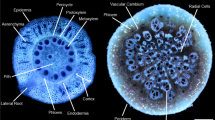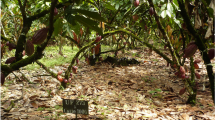Abstract
Eastern cottonwood (Populus deltoides Bartr. ex Marsh.) is commonly propagated using un-rooted cuttings. While cutting length and diameter, genetics and environmental conditions are often cited as major factors contributing to the successful establishment of cottonwood plantations, it is difficult to determine which specific cutting characteristic or mechanism leads to improved root establishment or plant development. For example, increasing stem size can affect rooting and subsequent plant growth by altering the cutting energy reserves as well as the surface area from which latent roots develop. In this study, the contribution of cutting length and belowground surface area to rooting and early growth was examined for eastern cottonwood. To discern cutting length effects, the belowground portion of four different cutting lengths was restricted so each cutting had the same belowground surface area available for rooting. To discern surface area effects, 40-cm-long cuttings were restricted to produce four different levels of surface area from which roots could develop. Leaf area, stem height, aboveground and belowground biomass, and root numbers were measured after 13 weeks of growth. The only statistically significant relationships related to biomass were due to the initial differences in cutting length. Cuttings with greater surface areas formed more lateral roots, while longer cuttings did not. By contrast, increased cutting lengths resulted in greater numbers of basal roots, but not for cuttings with greater belowground surface areas.


Similar content being viewed by others
References
Block RMA, Van Rees KCJ, Knight JD (2006) A review of fine root dynamics in Populus plantations. Agrofor Syst 67(1):73–84
Broadfoot WM, Bonner FT (1966) Soil compaction slows early growth of planted cottonwood. Tree Planters’ Notes 79:1–2
Carpenter LT, Pezeshki SR, Shields FD (2008) Responses of nonstructural carbohydrates to shoot removal and soil moisture treatments in Salix nigra. Trees 22:737–748
Chandler JW, Thielges BA (1973) Chilling and photoperiod affect dormancy of cottonwood cuttings. In: 12th southern forest tree improvement conference, Baton Rouge, LA, pp 200–205, 12–13 June 1973
De Klerk GJ, Van Der Krieken W, De Jong JC (1999) Review the formation of adventitious roots: new concepts, new possibilities. In Vitro Cell Dev Biol Plant 35:189–199
DesRochers A, Lieffers VJ (2001) Root biomass of regenerating aspen (Populus tremuloides) stands of different densities in Alberta. Can J For Res 31:1012–1018
DesRochers A, Thomas BR (2003) A comparison of pre-planting treatments on hardwood cuttings of four hybrid poplar clones. New Forest 26:17–32
DesRochers A, Landhäusser SM, Lieffers VJ (2002) Coarse and fine root respiration in aspen (Populus tremuloides). Tree Physiol 22:725–732
DesRochers A, Thomas BR, Butson R (2004) Reclamation of roads and landings with balsam poplar cuttings. For Ecol Manage 199:39–50
Dickmann D, Phipps H, Netzer D (1980) Cutting diameter influences early survival and growth of several Populus clones. St Paul (MN): U.S. Department of Agriculture, Forest Service, North Central Forest Experiment Station, Research Note NC-261, p 4
Fege AS, Brown GN (1984) Carbohydrate distribution in dormant Populus shoots and hardwood cuttings. For Sci 30(4):999–1010
Fernandez M, Tejero JR, Perez I, Soria F, Ruiz F, Lopez G (2007) Effect of copper coating nursery containers on plant growth and root morphology of Eucalyptus globulus L. cuttings and seedlings. Silva Lusit 15(2):215–227
Hansen EA, Tolsted DN (1981) Effect of cutting diameter and stem or branch position on establishment of a difficult-to-root Populus alba hybrid. Can J For Res 11:723–727
Hartmann HT, Kester DE, Davies FT, Geneve RL (2002) Plant propagation principles and practices, 7th edn. Prentice Hall, New Jersey, pp 367–374
Heilman PE, Ekuan G, Fogle DB (1994) First-order root development from cuttings of Populus trichocarpa × P. deltoides hybrids. Tree Physiol 14:911–920
Jasik J, De Klerk GJ (1997) Anatomical and ultrastructural examination of adventitious root formation in stem slices of apple. Biol Plant 39(1):79–90
Kaczmarek DJ, Rousseau RJ, Wright JA, Wachelka BC (2014) The influence of alternative plant propagation and stand establishment techniques on survival and growth of eastern cottonwood (Populus deltoides Bartr.) clones. New For 45:487–506
Kaps M, Lamberson WR (2009) Biostatistics for animal science, 2nd edn. CABI Publishing, Cambridge, MA
Kennedy HE (1977) Planting depth and source affect survival of planted green ash cuttings. New Orleans (LA): U.S. Department of Agriculture, Forest Service, Southern Forest Experiment Station. Forest Service Research Note SO-224, p 3
Landhausser SM (2003) Effect of soil temperature on rooting and early establishment of balsam poplar cuttings. Tree Planters’ Notes 50 (1): 34–37
Luxova M, Lux A (1981) The course of root differentiation from root primordial in poplar stems. Biol Plant 23(6):401–405
McCarthy WP (2011) Initial cottonwood cutting development modified by cutting length and belowground surface area available for rooting. MS Thesis, University of Arkansas-Monticello
McKnight JS (1970) Planting cottonwood cuttings for timber production in the South. New Orleans (LA): U.S. Department of Agriculture, Forest Service, Southern Forest Experiment Station. Forest Service Research Paper SO 60, p 17
Mohn CA, Randall WK, McKnight JS (1970) Fourteen cottonwood clones selected for Midsouth timber production. Southern forest experiment station, Stoneville, MS, p 18. USDA Forest Service Research Paper SO-62
Nelson LE, Switzer GL, Lockaby BG (1987) Nutrition of Populus deltoides plantations during maximum production. For Ecol Manage 20(1–2):25–41
Palanisamy K, Kumar P (1997) Effect of position, size of cutting and environmental factors on adventitious rooting in neem (Azadirachta indica A. Juss). For Ecol Manage 98:277–280
Pallardy SG, Gibbins DE, Rhoads JL (2003) Biomass production by two-year-old poplar clones on floodplain sites in the Lower Midwest, USA. Agrofor Syst 59:21–26
Pijut PM, Woeste KE, Michler CH (2011) Promotion of adventitious root formation of difficult-to-root hardwood tree species. In: Niemi K, Scagel C (eds), Adventitious root formation of forest trees and horticultural plants- from genes to applications. Horticultural Reviews 38: 213–251
Puri S, Thompson FB (2003) Effect of soil and plant water relations on rooting of Populus x euramericana stem cuttings. New For 25:109–124
Randall WK, Krinard RM (1977) First-year growth and survival of long cottonwood cuttings. New Orleans (LA): U.S. Department of Agriculture, Forest Service, Southern Forest Experiment Station. Forest Service Research Note SO-222, p 3
Richardson SG, Barker JR, Crofts KA, van Epps GA (1979) Factors affecting rooting of stem cuttings of salt desert shrubs. J Range Manage 32:280–283
Riemenschneider DE, Bauer EO (1997) Quantitative genetic analysis of adventitious root forming ability in Populus trichocarpa (Torr & Gray). In: Altman A, Waisel Y (eds) Biology of root formation and development. Plenum Press, New York, pp 193–201
Riemenschneider DE, Stanton BJ, Vallee G, Perinet P (2001) Poplar breeding strategies. In: Dickmann DI, Isebrands JG, Eckenwalder JE, Richardson J (eds) Poplar culture in North America. NRC Research Press, Ottawa, pp 43–76
Robison TL, Rousseau RJ, Zhang J (2006) Biomass productivity improvement for eastern cottonwood. Biomass Bioenergy 30:735–739
Schroeder WR, Walker DS (1991) Effect of cutting position on rooting and shoot growth of two poplar clones. New For 4:281–289
Smith NG, Wareing PF (1974) The distribution of latent root primordia in stems of Populus × robusta, and factors affecting the emergence of preformed roots from cuttings. Forestry 45(2):197–209
Stuhlinger HC, Toliver JR (1985) Variation in rooting among selected clones of eastern cottonwood (Populus deltoides Bartr. ex Marsh) in southern Louisiana. Tree Planter’s Notes 36(2):13–17
Tilley DJ (2006) Pre-soaking dormant willow and cottonwood cuttings. Aberdeen (ID): U.S. Department of Agriculture, Natural Resources Conservation Service, Plant Materials Center. 6429, p 11
Tilley DJ, Hoag JC (2008) Riparian/wetland project information series No. 24: effects of pre-plant soaking treatments on hardwood cuttings of peachleaf willow. Aberdeen (ID): U.S. Department of Agriculture, Natural Resources Conservation Service, Plant Materials Center 7668, p 7
U.S. Department of Energy (2011) U.S. Billion-Ton Update: Biomass Supply for a Bioenergy and Bioproducts Industry. R.D. Perlack and B.J. Stokes (Leads), ORNL/TM-2011/224. Oak Ridge National Laboratory, Oak Ridge, TN. p 227
Wiese AH, Zalesny JA, Donner DM, Zalesny RS Jr (2006) Bud removal affects shoot, root, and callus development of hardwood Populus cuttings. Silvae Genet 55:141–148
Zalesny RS Jr, Zalesny JA (2009) Selecting Populus with different adventitious root types for environmental benefits, fiber, and energy. In: Niemi K, Scagel C, Adventitious root formation of forest trees and horticultural plants- from genes to applications, Research Signpost, Kerala, pp 359–384
Zalesny RS, Wiese AH (2006) Date of shoot collection, genotype, and original shoot position affect early rooting of dormant hardwood cuttings of Populus. Silvae Genet 55:169–182
Zalesny RS, Hall RB, Bauer EO, Riemenschneider DE (2003) Shoot position affects initiation and growth of dormant unrooted cuttings of Populus. Silvae Genet 52:273–279
Zalesny RS Jr, Bauer EO, Riemenschneider DE (2004) Use of belowground growing degree days to predict rooting of dormant hardwood cuttings of Populus. Silvae Genet 53:154–160
Zalesny RS Jr, Riemenschneider DE, Hall RB (2005) Early rooting of dormant hardwood cuttings of Populus: analysis of quantitative genetics and genotype × environmental interactions. Can J For Res 35(4):918–929
Acknowledgments
The authors acknowledge the US Department of Energy MidSouth/Southeast Bioenergy Consortium for the funding for this project. We thank Jonathan Hartley and Ben Christiansen for their assistance throughout this project. This research was conducted while the corresponding author was at the University of Arkansas-Monticello.
Author information
Authors and Affiliations
Corresponding author
Rights and permissions
About this article
Cite this article
Schuler, J.L., McCarthy, W. Development of eastern cottonwood cuttings as modified by cutting length and surface area available for rooting. New Forests 46, 547–559 (2015). https://doi.org/10.1007/s11056-015-9482-8
Received:
Accepted:
Published:
Issue Date:
DOI: https://doi.org/10.1007/s11056-015-9482-8




